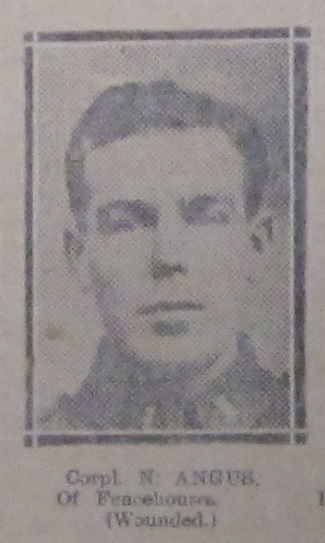
Norman Angus was born at Southwick, Co. Durham in 1890. He was working as a miner prior to enlisting in September 1914. He was posted to the 8th Battalion of the Yorkshire Regiment.
He would have been sent to France in September 1915 and he had a somewhat chequered career. He had been promoted to Corporal by early 1916 but was reduced to Private. He was wounded in December 1915 and again in September 1916 and unfortunately had to forfeit 6 days pay for unauthorised absence in 1917.
14043 Corporal Angus was awarded the 1915 Star, the British War Medal and the Victory Medal.
He died aged 84 in March 1975.
Explore more memories from the ribbon
-
Duncan Harvie
Vicki Walker of Little Crakehall called into the museum to show us a photograph of Duncan Harvie, her grandfather. The photo is a postcard addressed to ‘Mary and Sam’, sent on 3 April 1916 and shows a group of Signallers on board HMS Laconia. Duncan Harvie (5th South African Regiment) is sat at the front of the group with crossed legs. The ship’s log shows the Laconia (an armed merchant cruiser) to be anchored at Zanzibar on that date, on it’s way to British East Africa (now Kenya). The ship was used in the early part of the war to patrol the South Atlantic and the Indian Ocean, but in April 1915 her role changed and she was used as a headquarters ship to aid in the fight in German East Africa. Following her return to to Cunard, the Laconia was sunk by U-50 160 miles northwest of Fastnet while returning form the United States on 25th February 1917. Twelve people were killed following a double torpedo strike.
-
Ernest Pilcher
Peter Seaden-Jones visited us at a drop-in session at Richmond Station. From a photograph of his grandfather, we have managed to piece together the key details of Ernest John Pilcher’s war story. Ernest John Pilcher was born in Pietermaritzberg, Natal, South Africa in around 1881. According to the 1891 census, he appears to live in Chester as the 9 year old son of Frederick and Lucy Pilcher. He has a sister Edith and two brothers Archie and Arthur. His siblings are born in the U.K. but his father’s occupation as an Army Warrant Officer may explain Ernest’s birth in South Africa. On the 26th of December 1907 at the age of 26 he married Florence Alltimes at the Balham Hill Ascension church in Streatham. Florence was 23 years old at the time of their wedding. His occupation is recorded as a grocer. In the 1911 census Ernest and Florence were recorded as living at 23, Sussex street in Pimlico. He is listed as “Manager in the business of grocery stores”. Marjorie Edith their daughter was just 2 years old. At the age of 34 years and 6 months he enlisted in the army on the 22nd of November 1915. By this time his attestation record shows that he and Florence have a second daughter Peggy Dorothy born on the 6th of July 1913. Their address is now 20, Bellenden Road, Camberwell and his occupation is recorded as a “Traveller”. Although originally assigned to the Royal Field Artillery he transferred to…
-
Ewen George Sinclair-Maclagan
Ewen George Sinclair-Maclagan was born on the 24th December 1868 in Edinburgh. He was educated at the United Services College, Westward Ho! North Devon and commissioned as 2nd Lieutenant in the Border Regiment in 1898. He served in India, including the expedition to Waziristan in 1894-5, and was promoted Captain in 1898. He saw action in the 2nd Boer War (1899-1902) as an Adjutant in the 1st Battalion Border Regiment. He was severely wounded at Spion Kop, mentioned in dispatches and received the Distinguished Service Order. In 1901 he was posted to Australia when their Army was being organised, being appointed Adjutant to the New South Wales Scottish Rifles. On the 29th January 1902 he married Edith Kathleen, daughter of Major General Sir George French, at St’ Andrew’s Anglican Cathedral in Sydney. They would have one daughter. In 1904 Maclagan resumed regimental duty in Britain. Promoted Major in 1908 he then transferred to the Yorkshire Regiment. In 1910 Major General Sir William Bridges, who had known Maclagan in Australia, was recruiting for staff for the Royal Military College in Duntroon, Canberra. He made Maclagan director of drill with the rank of Lieutenant-Colonel. When Bridges raised the 1st Division Australian Imperial Force (AIF) he chose Maclagan to command the 3rd Infantry Brigade. On the 25th April 1915 landed at Gallipoli. A ridge leading from Anzac Cove is named after him. He would stay on the peninsula until evacuated sick in August 1915. He did not return to his Brigade in Egypt…
